[Apple II, SSI]
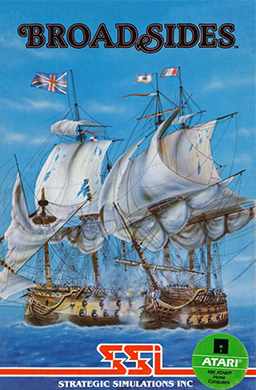
Do you like challenging commands, Lieutenant Narwhal?
Yes of course !
Then you will command a Spanish ship !
A Spanish ship ?! You did not tell me there would be Spanish ships, Sir ! Worst I can do is a French ship, Sir!
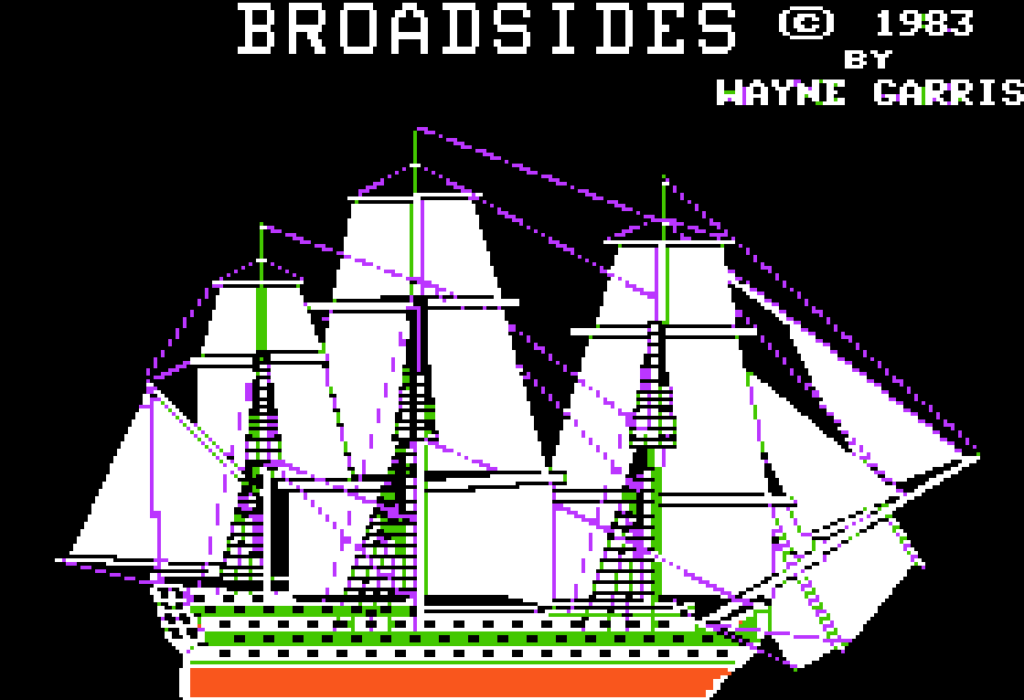
On the 9th of February 1799 On 19th Pluviôse Year VII, the French ship L’Insurgente was captured after a short combat by the American ship USS Constellation – the first naval combat of the young Navy after the American Revolution.
Wayne Garris’s Broadsides allows me to try to reverse this minor setback and alter the course of the Quasi-War ! An initial victory against the Constellation will offer France a marginally stronger bargaining position and, possibly, allow Mr Talleyrand to finally extract a bribe from the Americans ! This is a high stake combat !
I have a daunting task ahead of me. The French ships are well-designed, but the American ships are the best of the era, and the Constellation is no exception : it has better speed, better turning rate and better hull (“HP”) than L’Insurgente.
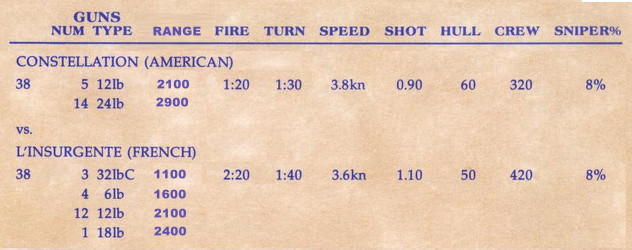
The Constellation also has considerably more firepower, with fourteen 24-pounders on each side when most French guns are 12-pounders. Worse ! The training of the French gunners is awful, and the American ship can shoot 5 times in the time it takes for the French to shoot 3 times. All-in-all, the Constellation has probably around twice the punch of L’Insurgente, something the better quality of the French ammunition does not compensate. There is a reason why historically L’Insurgente tried to avoid combat.
The only advantage of L’Insurgente is the larger crew size – but to leverage it of course she needs to catch the faster Constellation. My strategy as the capitaine of the French ship will be to focus my fire exclusively on the Constellation’s sails with chained shots and, once she is slowed down enough, board her. De l’audace, encore de l’audace et caetera.
The game always starts with the two ships immediately shooting at each other, and this battle is no exception.
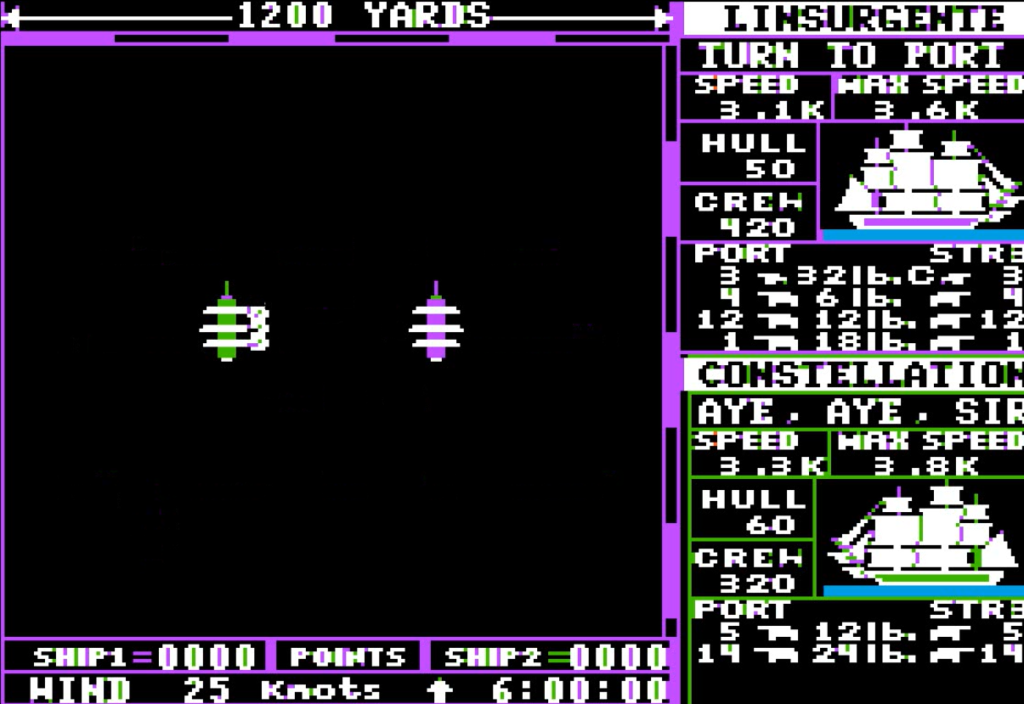
It is not a good start for L’Insurgente, given the firepower advantage of the Constellation. I immediately turn to port and slow down to pass behind the Constellation :
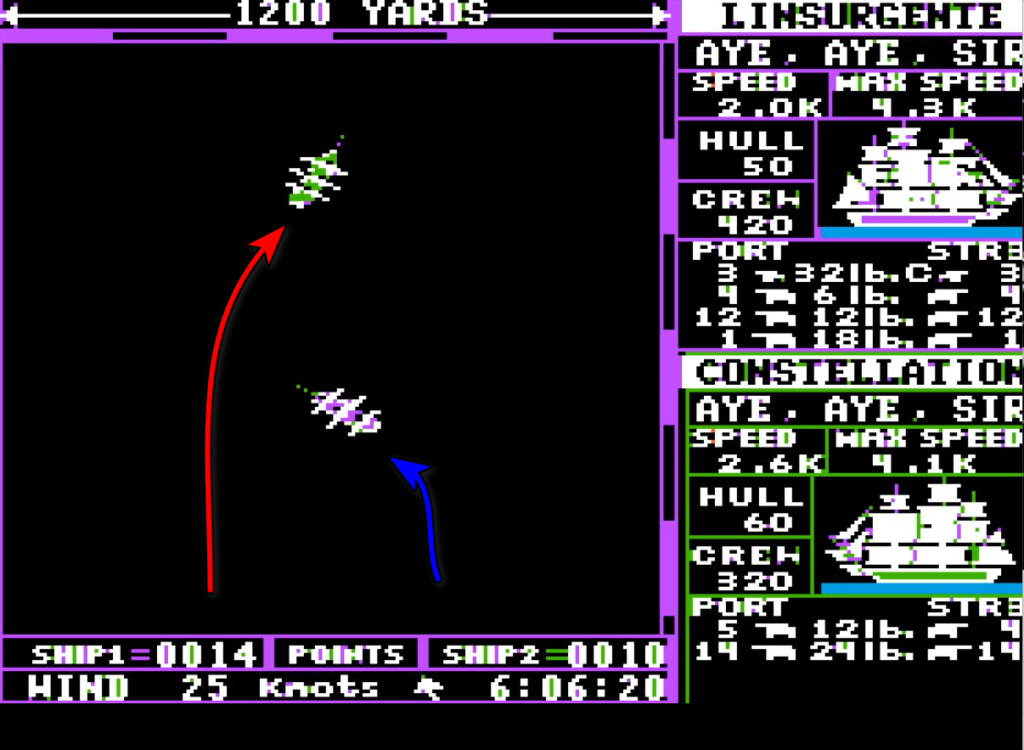
This puts me in a good position to shoot without fear of retaliation :
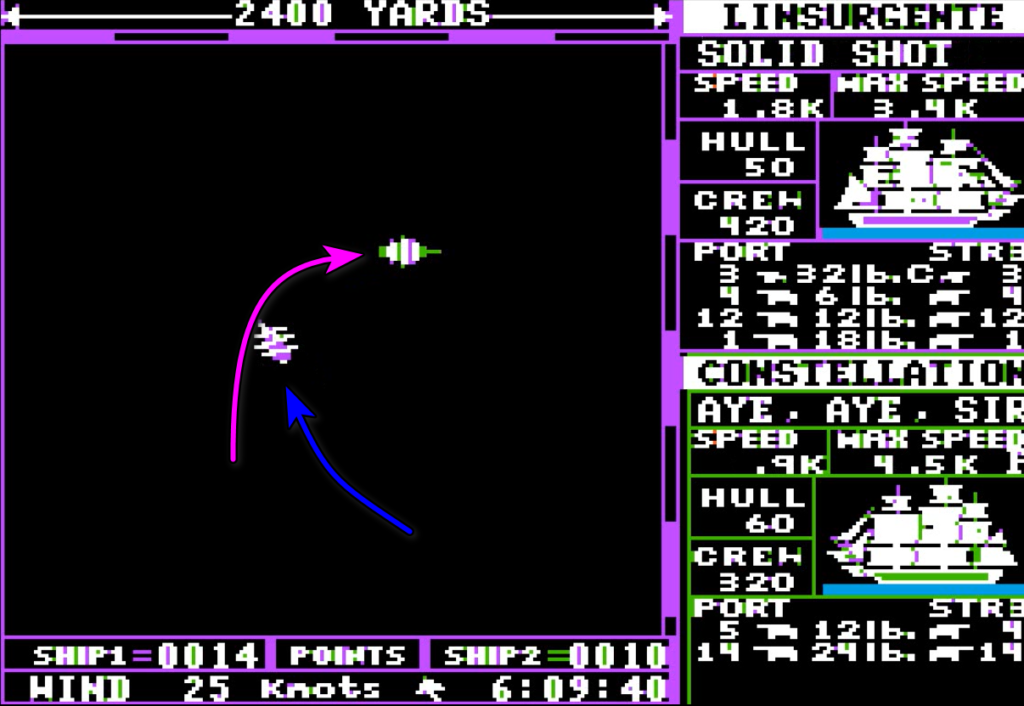
Alas, with the wind in my back I do not slow down enough, and the radius of the circle I make around the Constellation is way too large. It allows the Constellation to show me her deadly sides again :
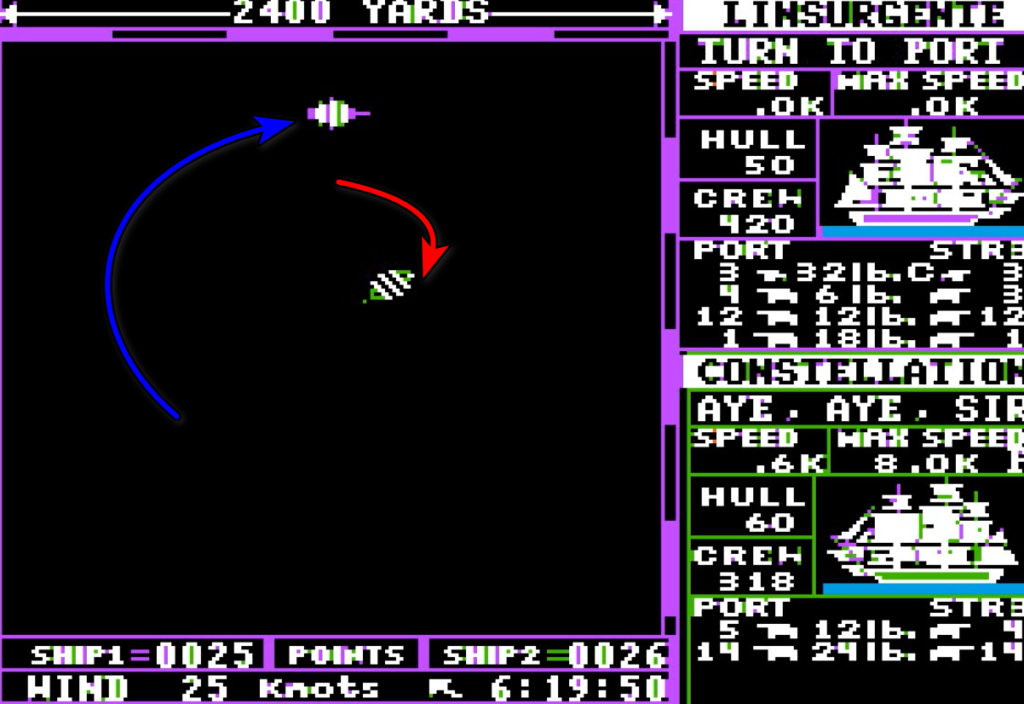
After some manoeuvring where I try to approach the Constellation without getting blasted, I decide to disengage.
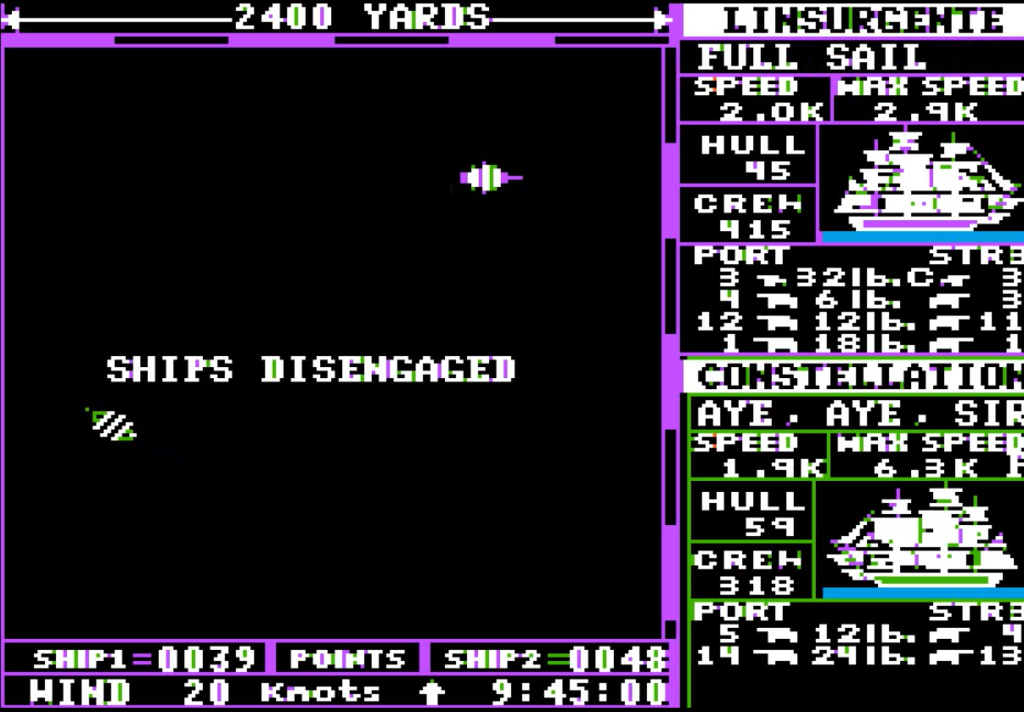
After disengagement, the ships receive some minor repairs and are then spawn next to each other. The American ship immediately shoots me, and steers to her port.
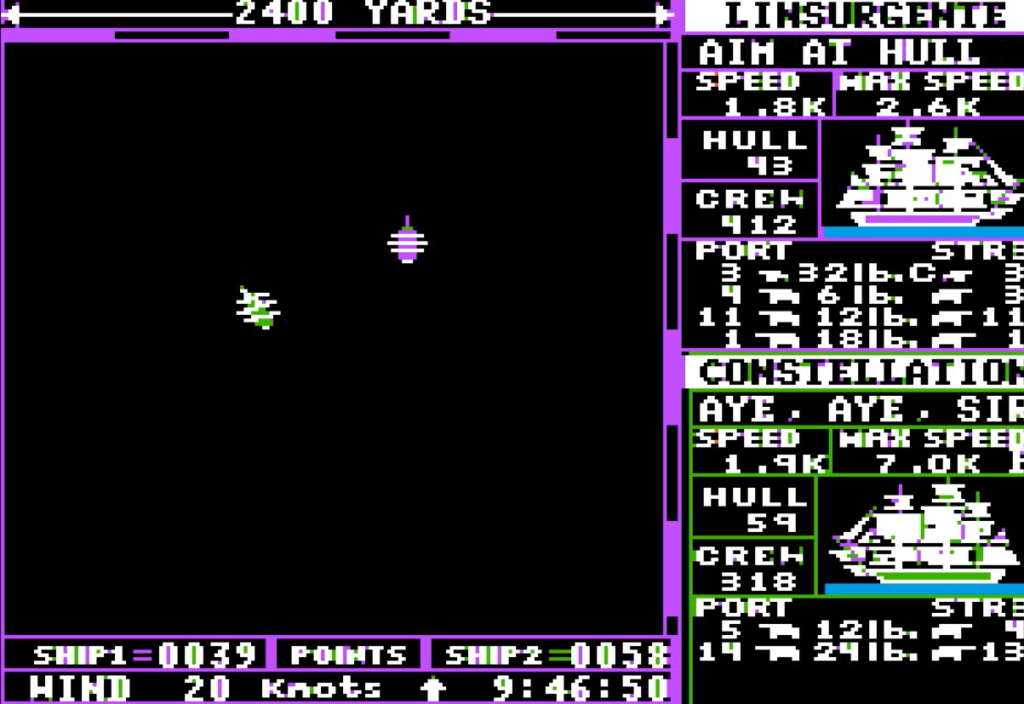
While my ship receives some damage to her hull, my sails are in better shape than the Constellation‘s. I am also upwind, which means I have a positional advantage. I turn to my port and beeline for her :
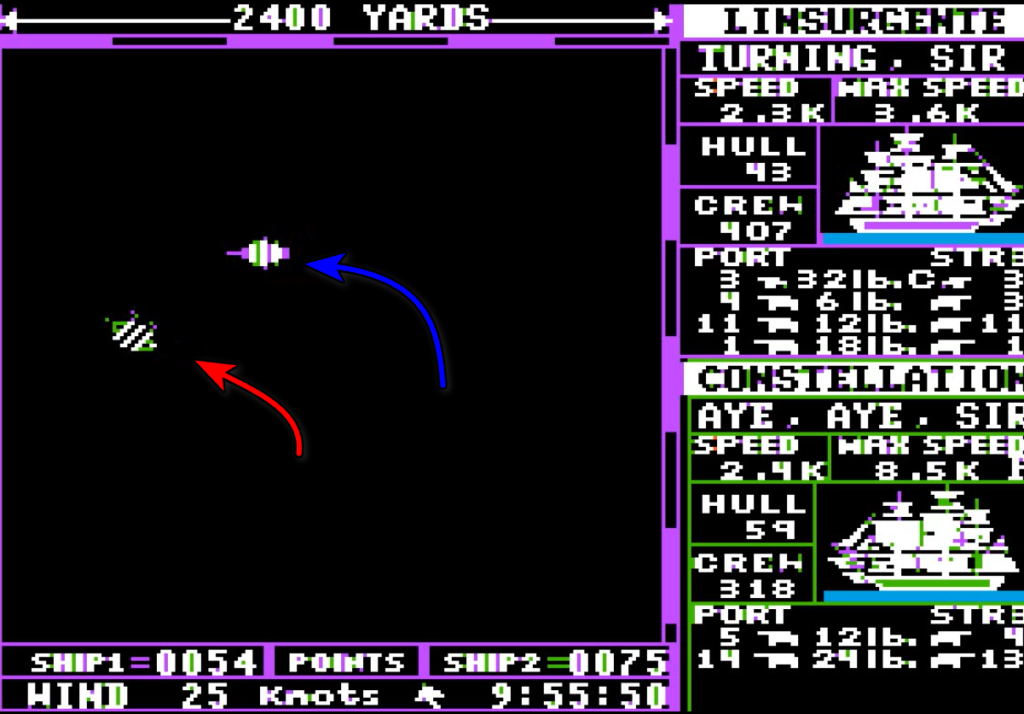
But the Constellation has a tailwind and escapes me. Still, I am in a good position to shoot some more without fear of retaliation.
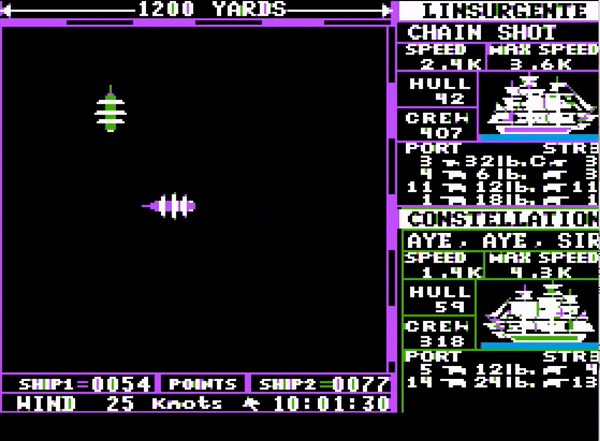
Once again my excessive speed allows the Constellation to show me its side. Déjà vu.
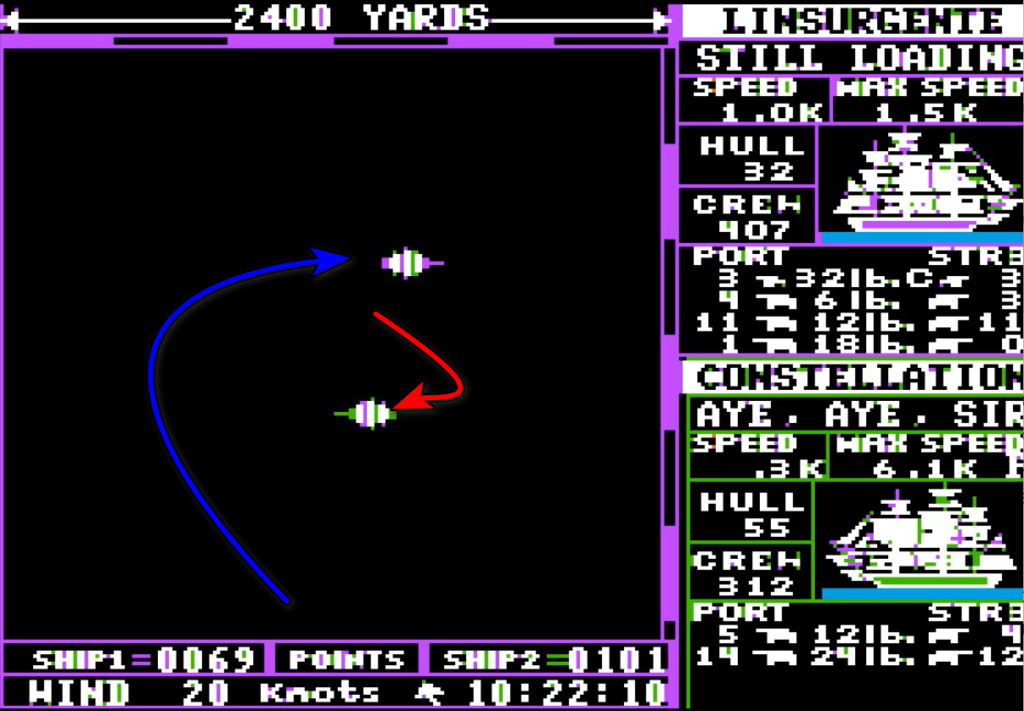
Except this time, I come back at high speed :
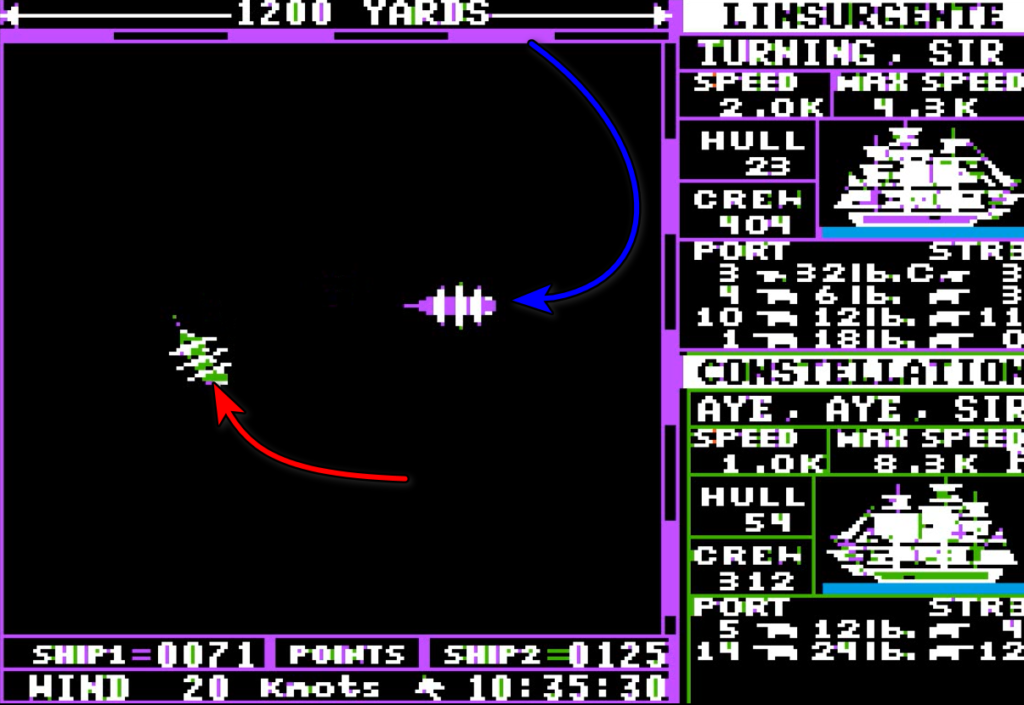
Arriving from the side, I am the perfect target, but the Constellation cannot build enough speed to evade me :
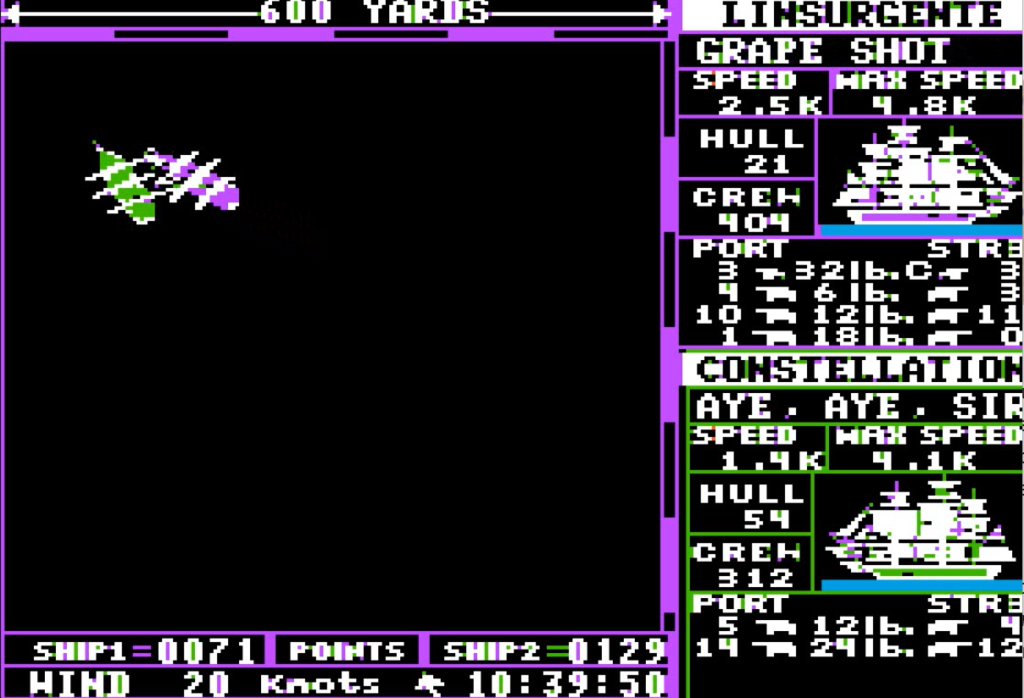
And it is BOARDING TIME ! Now I have a chance !
The way boarding is resolved in Broadsides is by a game of rock-paper-scissors, or more specifically low counter-thrust / middle thrust / high hack. This is of course totally historical, and first used by the Count of Rochambeau at the Battle of the Chesapeake, hence the American word “roshambo“. Sometimes, this noble game is interrupted by snipers shooting at the sailors or at other snipers. Very unsportsmanlike.
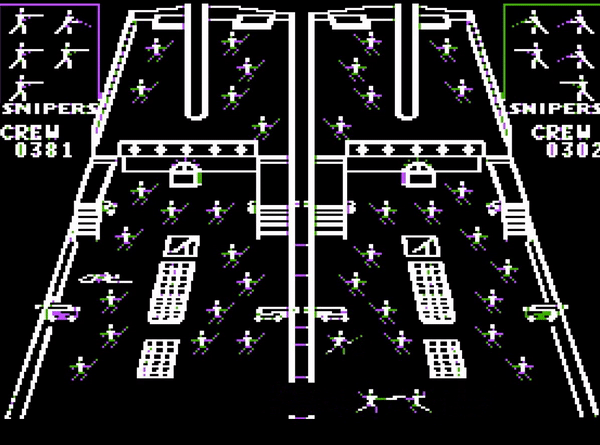
Hitting the other fighter in the rock-paper-scissor duel causes some losses to the other side. Every time a side loses 10 men its “champion” falls down and another duel starts in the middle of the screen. The winning side can then add a sailor on the other ship (if the kill happened on the other ship) or remove a sailor that crossed (if the kill happened on the ship of the winner). A grappling line between the two ships also gets added or removed.
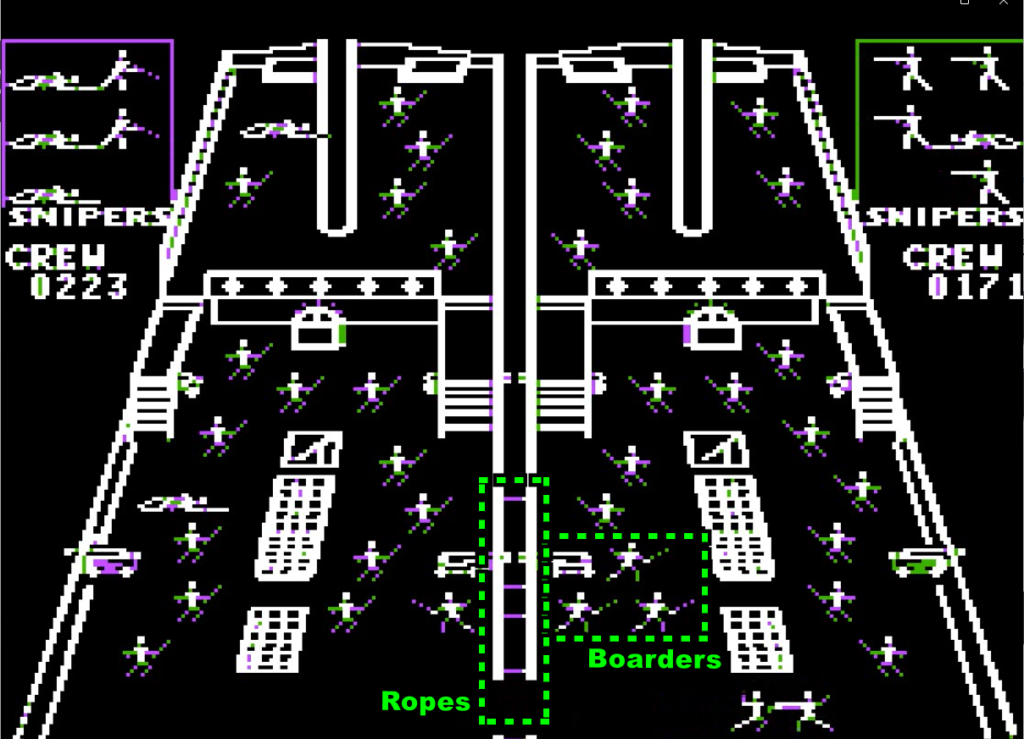
Once 11 sailors manage to cross, they capture the other ship. But if there are no more grappling lines between the two ships, then the boarding attempt is stopped and the game returns to the ship combat screen.
This arcade gameplay is boring and long (12 minutes !). Since I had more crewmen I was expecting to win by eliminating the entire American crew.
But I had a string of bad luck, and the Americans managed to cut all the ropes with only 133 men left !
This puts me in the following situation :
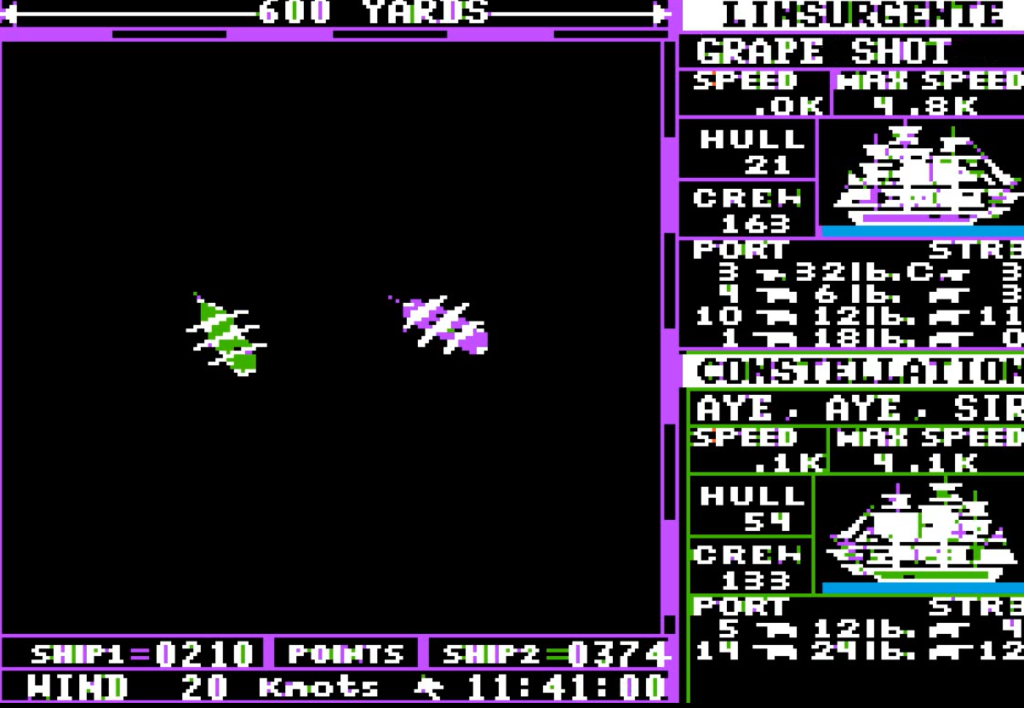
Right in front of their guns, but unable to shoot back. Current speed : 0.
L’Insurgente was already badly battered, and two additional salvos were enough to force her to strike her colours:
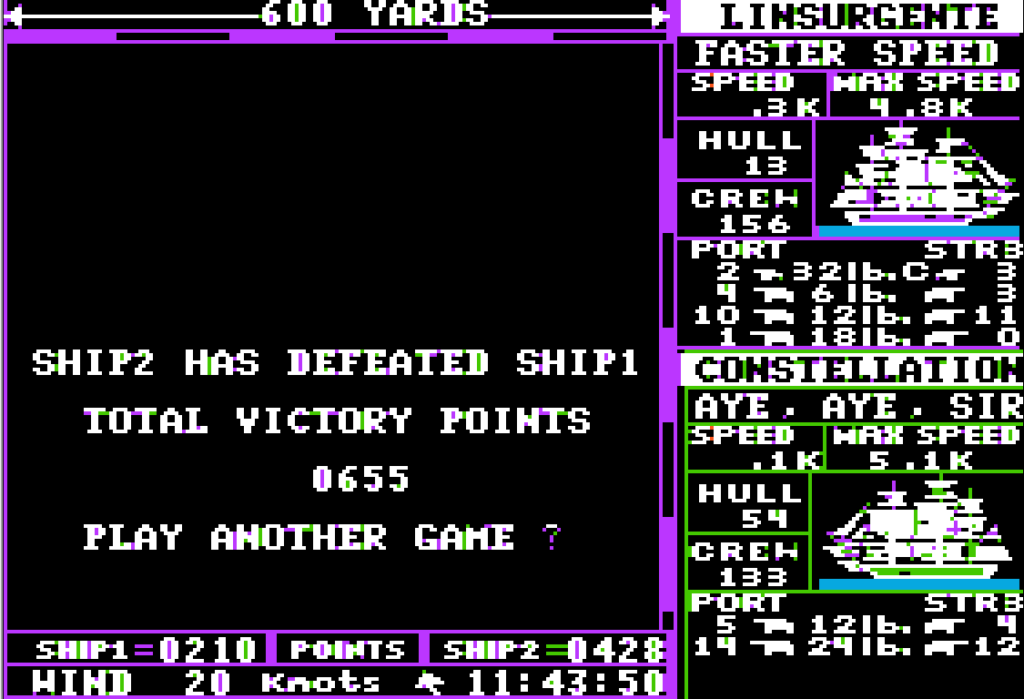
This year, Mr Talleyrand will not be buying designer silk stockings !
Rating and Reviews
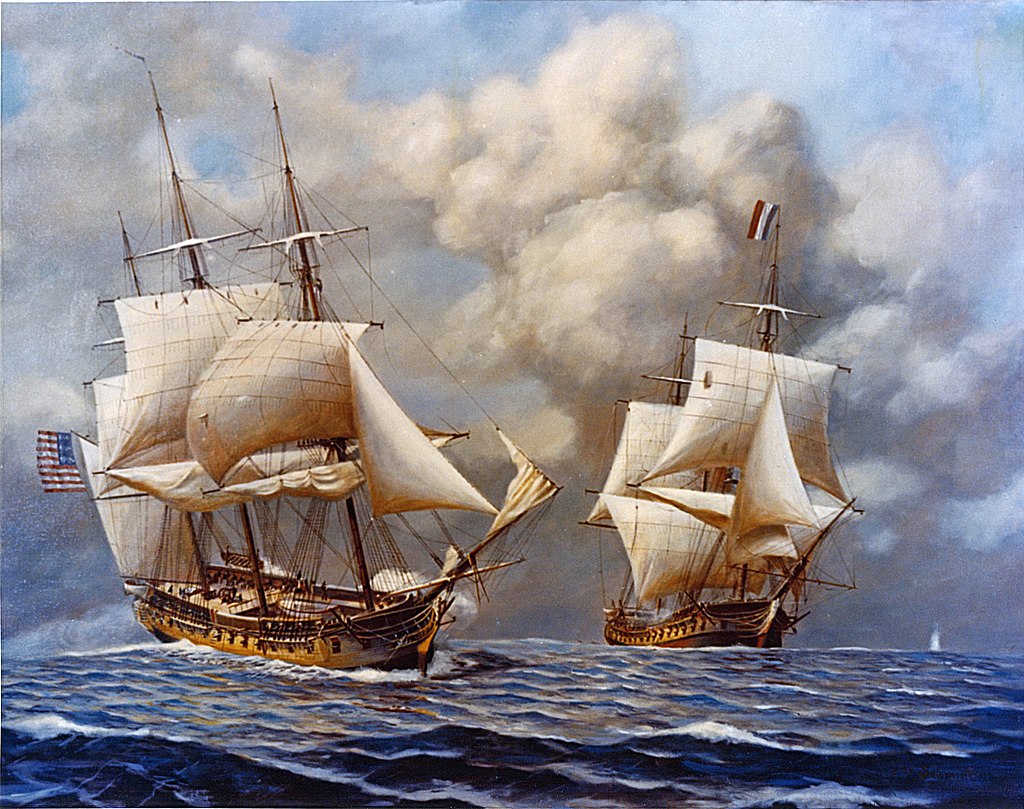
Broadsides by Wayne Garris, published by SSI
First release : August 1983 on Apple II
Tested on : AppleWin emulator
Total time tested : Around 2 hours
Average duration of a campaign: 15 minutes, +15 minutes if there is a boarding
Complexity: Simple (1/5)
Would recommend to a modern player : No
Would recommend to a designer : No
Final Rating: Flawed and obsolete
Ranking at the time of review : 44/80
Unfortunately, I have little context for the production of this game. Its designer-programmer, Wayne Garris, is not credited on any other game and SSI’s founder Joel Billings has no recollection of him. The game itself was initially released on Apple II in August 1983, with ports for Commodore and Atari in 1984. There are no differences between the platforms, but the two ports use the second edition of the game (released in Summer 1984), which adds more pre-made scenarios and has an option where you don’t need to guess the range when shooting.
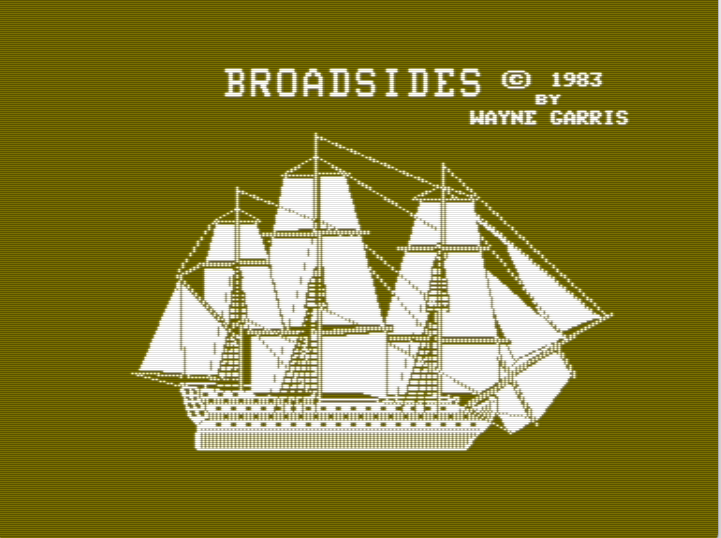
Broadsides was sold at the lower $39.95 price point and only included a (beautiful) manual in addition to the game disk.
A. Immersion
Acceptable – The game punches way above its era. First, it is the first real-time game on this blog that feels “smooth”. In the early real-time wargames I have covered so far, (Legionnaire, Cytron Masters, Combat Leader) the units were “jumping” from tile to tile. Here, the ships glide gracefully on the sea, it is hard to describe how modern it feels.
Moreover, its naval battle graphics would not be considered out of place in a modern pixel-art indie game, at least for Apple II. The graphics are not as sharp on Atari and Commodore 64, but still acceptable :
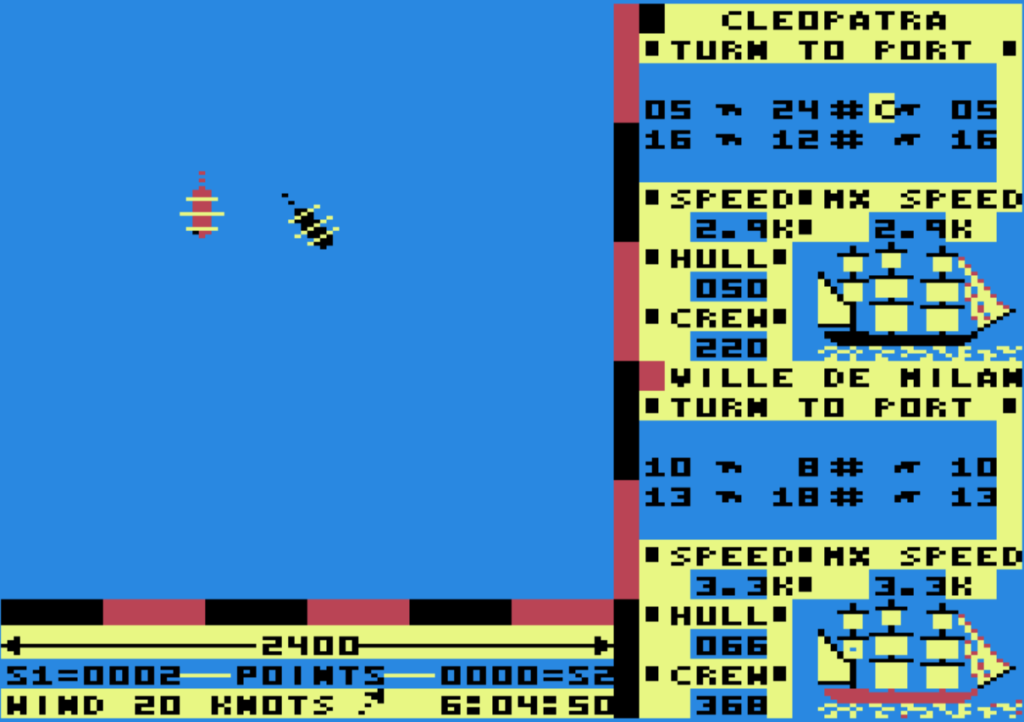
Alas, this is marred by the graphics used in the boarding part of the game – they look dated, not indie. This is even more true for the ports :
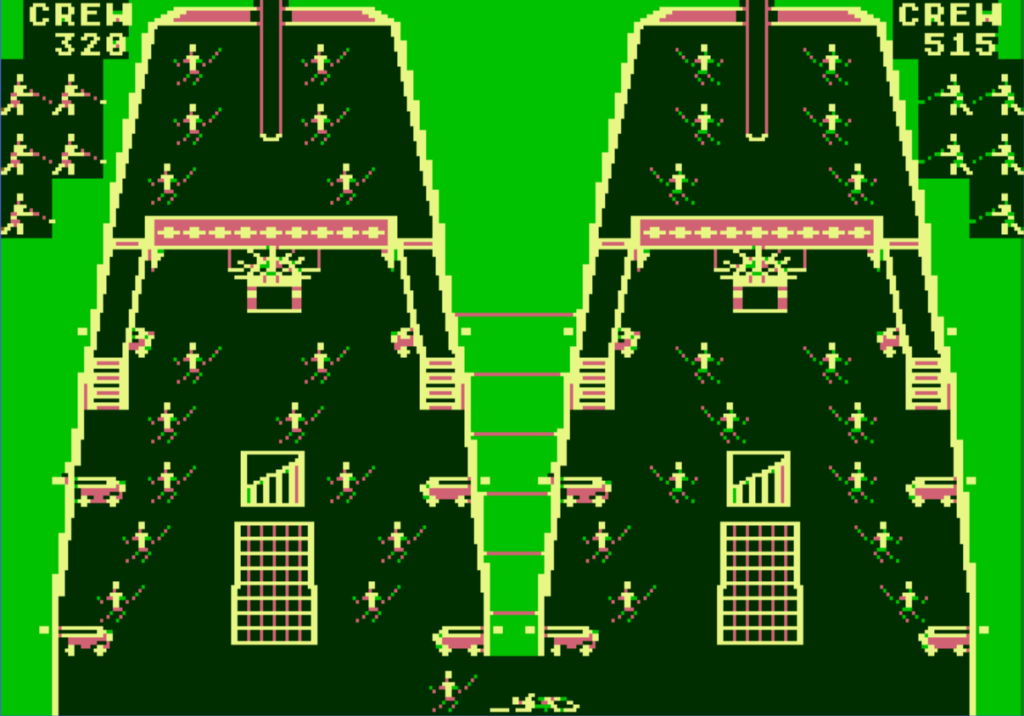
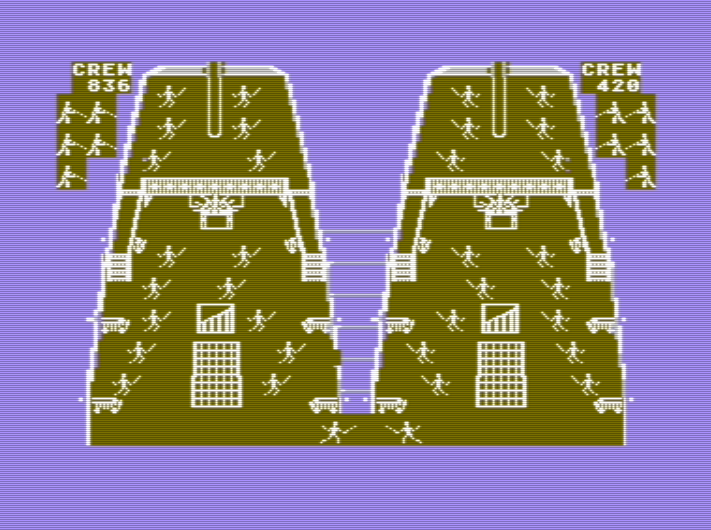
B. UI , Clarity of rules and outcomes
Good. The naval combat of the game is controlled by scrolling through a list of commands like “turn port”, “increase speed”, … with whatever device a given computer supports (keyboard, paddle, or joystick). There are no short keys, which is occasionally frustrating because “turn port” is at the beginning of the list and “fire” at the end. Still, it is simple and efficient.
The first edition of the game had a “guess distance” mini-game where you had to pick a distance between three proposed to you every time you shoot – and if you were wrong you would just miss. Fortunately, the Apple v2 edition and the two ports allowed you to remove this “feature”.
C. Systems
Very poor. The naval combat part of the game is only superficially deep, with only a few strategic options available to the player :
- speed : accelerate, slow down, steady
- ammunition : chain, grape or solid
- sail arrangement : full sails for speed or combat sails to minimize damage
- target : enemy sails or enemy hull
- one special order : back the sail, to lose speed quickly
There is an “arcade” mode with even fewer choices, but to be honest I don’t find the “tactical” mode realistic either. To take several examples :
- the only impact of the wind is on the speed of the ships (eg. turning against the wind takes as much time as turning toward it),
- some orders take time to execute (turning, backing the sails or changing their arrangement) but most are immediate, including changing the ammo type or accelerating / decelerating,
- a ship with a reduced crew loses its rate of fire, but otherwise performs just as well as a fully crewed ship.
The simplifications may have been acceptable if the game had several ships fighting at the same time, but the game only features ship duels. Trek73 ten years earlier had more tactical depth.
And then there is the boarding part of the game and it is downright terrible. Theoretically, there are some tactics you can use, but provided the crew of the ships fighting is at least medium-sized, tactics is going to be irrelevant because the winner is going to be decided by the rock-paper-scissor instant death (or instant escape). And if no one manages to trigger an instant death, I pity you, because those battles are tedious. It took me 12 minutes to bring the Constellation from 310 men to 130 men so imagine a battle involving ships of 800 men or more.
D. Scenario design & Balancing
Very poor. The game is not deep, but it is not “wide” either. All the battles are one ship against another in the open sea, and ends when a ship sinks, is captured, surrenders (if the difference in damage/crew lost is too great) or after 12 hours of battle. In the latter case, the game uses a point system to determine who won and who lost.
The game proposes 10 historical duels spanning from the American Revolution (USS Bonhomme Richard vs HMS Serapis) to the War of 1812 (USS United States vs HMS Macedonian), plus a fantasy HMS Victory vs USS Constitution, for those of us who like to see museum ships fight. You can also create your own ships, with the manual telling you what would be the stats of a typical ship from France, Britain, United States and Spain. Still, the battles mostly play the same, and without a campaign mode there is nothing at stake.
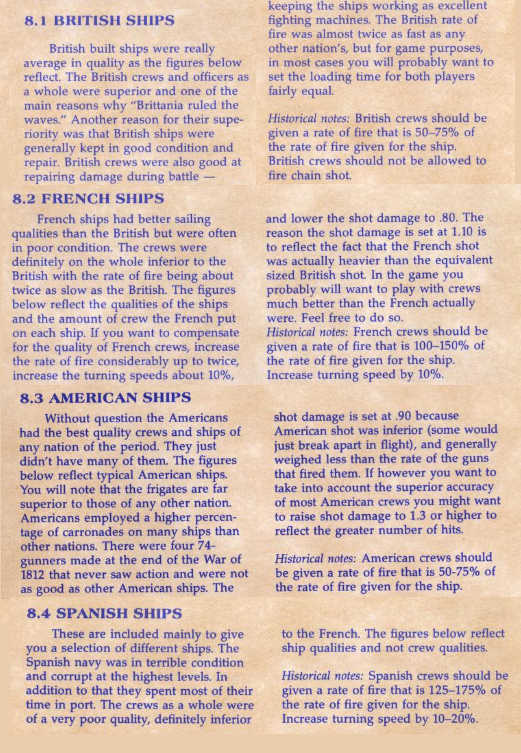
The AI is weak and needs some serious advantage in firepower (like in the AAR) to be challenging.
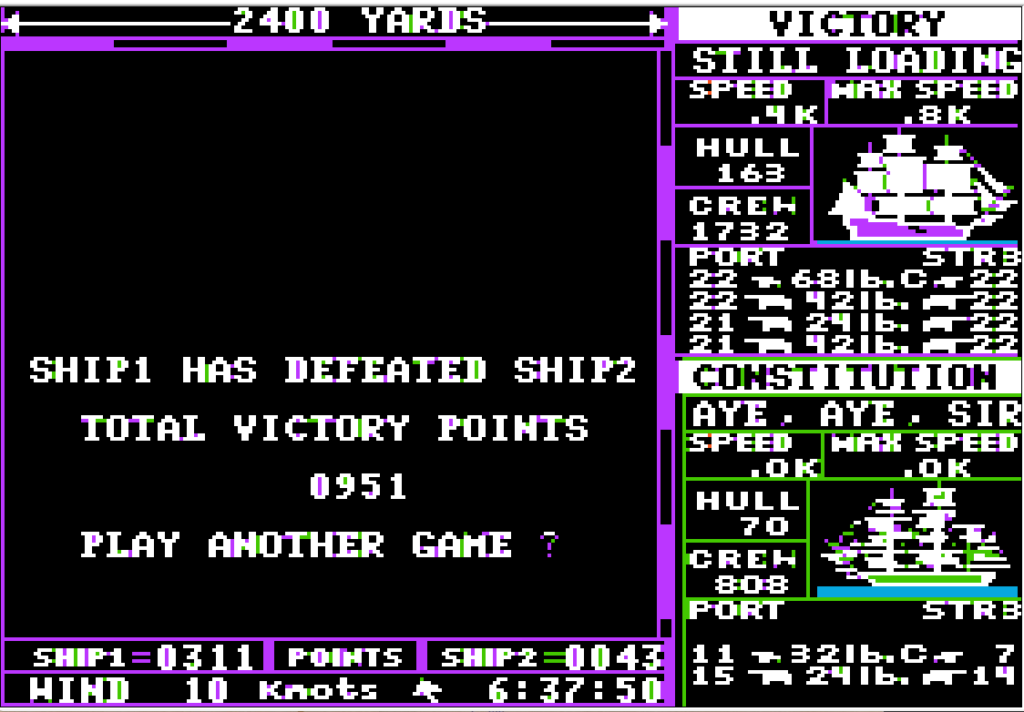
E. Did I make interesting decisions ?
Barely.
F. Final rating
Flawed and obsolete. Broadsides was a technical prowess at its release, but fundamentally the game is shallow and repetitive and there is nothing here to retain the attention of the modern gamer.
Contemporary Reviews
Broadsides made quite the wave at its release, especially among the staff of Computer Gaming World, where it first received a rave review by Dave Long in December 1983 (“Broadsides is an excellent depiction of ship-to-ship combat […] The graphics are very pleasing, and the historical statistics presented allow you to create a virtually unending array of different battle situations”) before being the topic of an AAR by Jay Selover in June 1984 :
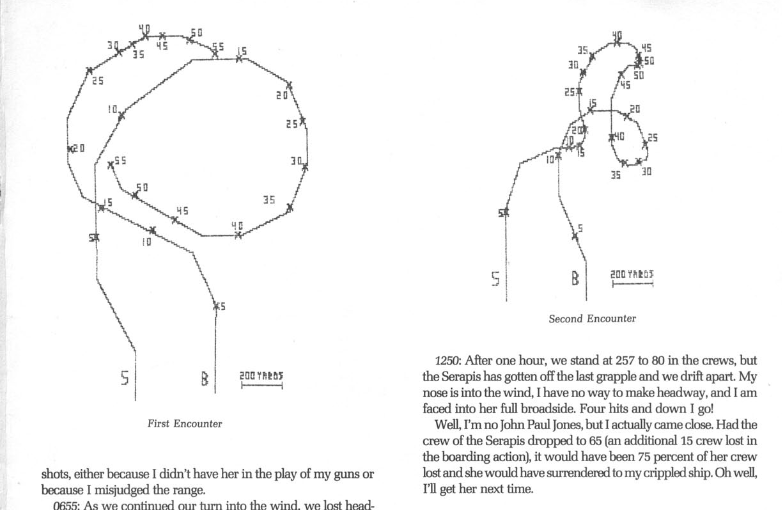
7 years after the release of the game, Evan Brooks in his review of all pre-modern wargames (October 1990) gives the game 5-stars, calling it the standard for Age of Sail warfare. Three years later (June 1993), Brooks still gives the game 3 stars and half, stating he still occasionally plays it on his Atari 800.
Other magazines are a bit more nuanced and find flaws with the game :
- I am vindicated by Softtalk‘s review in December 1983, which complains about the “range guessing” mini-game, explaining : “Distance seems already to have been factored into the damage done, with guns aimed individually, not as a broadside. Having to guess the exact range isn’t needed to make hitting more difficult.” The review concludes that the game has “a good level of historical detail and a good feel for its subject overall”.
- Steve Panak writing for Analog Computing Magazine (January 1986) states that the game is “so good that I’ll have to recommend it, especially for budding sailors. Broadsides sinks its competition and sails into port as one of the better simulations of the year.” The puns having been made, Panak is more moderate one paragraph later, merely calling the game only “actually good”. Just like me, Panak does not like the boarding arcade game. This opinion is shared by Bernadette Colson, who wrote a full review in the French Tilt in May 1985, where she praises the tactical part of the game, but asserts that the boarding part is “less involving“.
Broadsides sold more than 23 000 copies in the USA, making it the highest-selling wargame published by SSI thus far (Computer Baseball and Computer Quarterback did better). As for me, I hope to reach 1987 so I can explain why Ancient Art of War at Sea is so much better !
Be First to Comment